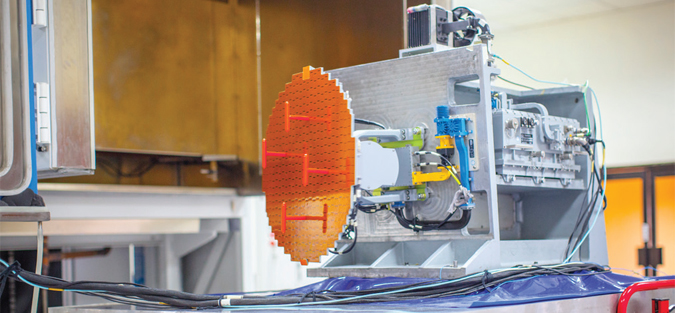Grifo Radar
Grifo radar is multi-mode pulse Doppler all weather fire control radar. PAC has the capability of not only producing the airborne fire control radars but also has vast experience in maintaining three variants of Grifo radars. PAC has produced a number of Grifo radar systems for PAF Fleet in collaboration with M/S Selex Electronic Systems Italy. Grifo family of radars is digital fire control system designed to improve air to air and air to ground performance. Radars are capable of detecting and tracking the targets at all altitudes and all aspects. Radars have powerful and accurate Built-In Test (BIT) system followed by auto calibration for the ease of smooth operation and better maintenance.KLJ-7 Airborne Radar
The KLJ-7 is an X-band airborne fire-control radar (FCR) that uses a mechanically-steered slotted array antenna. The KLJ-7 has multiple modes, both beyond-visual-range (BVR) and close-in air-to-air modes, ground surveillance modes and a robust anti-jamming capability. The radar can manage up to 40 targets, monitor up to 10 of them in track while scan (TWS) mode and simultaneously fire on two BVR targets.Radar Warning Receiver (RWR)
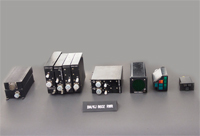 Radar Warning Receiver (RWR) is being co-produced in
collaboration with M/s CEIEC China and is designed to provide
the pilot with real time and unambiguous threat warning over 360
degrees thus reducing vulnerability of the combat aircraft to
radar associated weapons. Currently two different models of RWR
are available i.e. BM/KJ-8602 RWR and BM/KJ-8602A RWR. PAC also
provides the life cycle maintenance of these two RWR models to
PAF.
Radar Warning Receiver (RWR) is being co-produced in
collaboration with M/s CEIEC China and is designed to provide
the pilot with real time and unambiguous threat warning over 360
degrees thus reducing vulnerability of the combat aircraft to
radar associated weapons. Currently two different models of RWR
are available i.e. BM/KJ-8602 RWR and BM/KJ-8602A RWR. PAC also
provides the life cycle maintenance of these two RWR models to
PAF.
Global Attitude Heading Reference System (GAHRS)
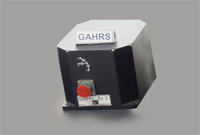 Global Attitude Heading Reference System (GAHRS)
is an avionics subsystem of JF-17 aircraft which provides high
performance measurement of aircraft attitude by using highly
reliable optical fiber gyroscopes and accelerometers. GAHRS is
a backup system of Inertial Navigation System (INS). In case of
INS failure, it provides roll, pitch and heading information to
Weapon Mission Management Computer (WMMC) using RS 422 interface.
Global Attitude Heading Reference System (GAHRS)
is an avionics subsystem of JF-17 aircraft which provides high
performance measurement of aircraft attitude by using highly
reliable optical fiber gyroscopes and accelerometers. GAHRS is
a backup system of Inertial Navigation System (INS). In case of
INS failure, it provides roll, pitch and heading information to
Weapon Mission Management Computer (WMMC) using RS 422 interface.
Identification of Friend or Foe (IFF)
 Identification of Friend or Foe (IFF) system is solid state,
airborne and selective transponder being co-produced in
collaboration with M/s JIUZHOU China. It is used for
identification of friend or foe. The system is compatible which
civil ATC radar beacon system for air traffic control. PAC also
provides the life cycle maintenance support to the JZ/YD 125 IFF
system.
Identification of Friend or Foe (IFF) system is solid state,
airborne and selective transponder being co-produced in
collaboration with M/s JIUZHOU China. It is used for
identification of friend or foe. The system is compatible which
civil ATC radar beacon system for air traffic control. PAC also
provides the life cycle maintenance support to the JZ/YD 125 IFF
system.
Integrated Survivable Recorder (ISR)
 Integrated Survivable Recorder (ISR) is an
important LRU of aircraft Electro Mechanical Management System (EMMS).
It receives flight and audio data being sent from
electromechanical management computer through HDLC bus and
records them in crash survival memory unit (CSMU). After
recording the data in accordance with the bus commands, it
downloads the recorded data and sends it to electromechanical
management computer.
Integrated Survivable Recorder (ISR) is an
important LRU of aircraft Electro Mechanical Management System (EMMS).
It receives flight and audio data being sent from
electromechanical management computer through HDLC bus and
records them in crash survival memory unit (CSMU). After
recording the data in accordance with the bus commands, it
downloads the recorded data and sends it to electromechanical
management computer.
Light Warning System (LWS)
 Light warning system is used to display
emergency warning signals. It's main purpose is to draw the
pilot's attention to the warning signals for a proper timely
action. It has a Built in Test Function for checking its
serviceability and provides four warning levels according to
degree of emergency related to flight safety and mission plan.
Light warning system is used to display
emergency warning signals. It's main purpose is to draw the
pilot's attention to the warning signals for a proper timely
action. It has a Built in Test Function for checking its
serviceability and provides four warning levels according to
degree of emergency related to flight safety and mission plan.
Stores Management System (SMS)
 SMS is able to manage and control guns, bombs, external tank
and stores such as armament at stations and pods which comply
with MIL-STD-1760C-97. It also ensures that stores functions are
carried out in addition to offering certain safety measures.
SMS is able to manage and control guns, bombs, external tank
and stores such as armament at stations and pods which comply
with MIL-STD-1760C-97. It also ensures that stores functions are
carried out in addition to offering certain safety measures.
Smart Head Up Display (SHUD)
 SHUD is an integrated electro optical display unit, and is
one of the important units of aircraft. It is the main window
which provides flight and combat information to the pilot. It
employs command control mode to generate flight symbology
required in navigation and combat. The displayed symbology are
imaged to infinity and superimposed with outside scene,
enabling the pilot to view the displayed information without
adjusting eyes while observing the outside scene. The unit is
NVIS compatible. It outputs superimposed video signals for
recording, so as to provide evidences for combat and training
analysis.
SHUD is an integrated electro optical display unit, and is
one of the important units of aircraft. It is the main window
which provides flight and combat information to the pilot. It
employs command control mode to generate flight symbology
required in navigation and combat. The displayed symbology are
imaged to infinity and superimposed with outside scene,
enabling the pilot to view the displayed information without
adjusting eyes while observing the outside scene. The unit is
NVIS compatible. It outputs superimposed video signals for
recording, so as to provide evidences for combat and training
analysis.
Instrument Landing System (ILS)
 ILS is used for aircraft approach and landing. It receives
and processes the signals transmitted from ground localizer and
glide-slope stations. It provides pilot deviation information
from the given course and glide path so as to lead aircraft to
the visual runway entrance according to the correct path track.
The equipment is one of the essential systems which ensures safe
landing of the aircraft under adverse weather conditions.
ILS is used for aircraft approach and landing. It receives
and processes the signals transmitted from ground localizer and
glide-slope stations. It provides pilot deviation information
from the given course and glide path so as to lead aircraft to
the visual runway entrance according to the correct path track.
The equipment is one of the essential systems which ensures safe
landing of the aircraft under adverse weather conditions. Back Up Acquisition Computer (BAC)
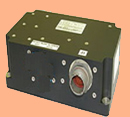 BAC is a back up computer for avionics systems and provides
flight critical information to the pilot in case of main bus /
mission management computer failure. BAC accepts data from flight critical systems on a separate RS 422 data line and
communicates the same to Multi Function Displays. It also
provides excitation voltage to hydraulic and brake sensors.
BAC is a back up computer for avionics systems and provides
flight critical information to the pilot in case of main bus /
mission management computer failure. BAC accepts data from flight critical systems on a separate RS 422 data line and
communicates the same to Multi Function Displays. It also
provides excitation voltage to hydraulic and brake sensors.Inertial Navigation System (INS)

Radar Altimeter provides data on 1553 Bus pertaining to aircraft actual height above ground level. This data can be displayed on Head Up Display (HUD).
Smart Multi Function Colour Display (SMFCD)

SMFCD is a NVIS compatible display providing the graphical interface of the avionics & non-avionics systems to the pilot. Input to SMFCDs are 1553B data bus, RS-422 XGA In/out and RGB Video Out.
Central Suppression Unit (CSU)
Aircraft are equipped with multiple avionics systems consisting of both active and passive systems. It requires an intelligent electromagnetic management system which can ensure co-existence of high power transmitters and high sensitivity receivers. Central Suppressor Unit (CSU) ensures optimum utilization of electromagnet spectrum on board JF-17 aircraft.Weapon Mission Management Computer (WMMC)
 WMMC is a central computer for JF17 aircraft avionic system
control and management. The basic tasks of WMMC are multiplex
data bus communication management, mission planning and flight
program management, fire control calculation, navigation
assistance, audio alarming, integrated display managing (including
digital map display control) and pilot interface control for
avionics systems.
WMMC is a central computer for JF17 aircraft avionic system
control and management. The basic tasks of WMMC are multiplex
data bus communication management, mission planning and flight
program management, fire control calculation, navigation
assistance, audio alarming, integrated display managing (including
digital map display control) and pilot interface control for
avionics systems.
Electro Mechanical Management Computer (EMMC)
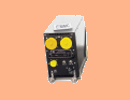
EMMC has the capability of communicating with Non-avionics systems of JF-17 aircraft. The computer collects data from various aircraft systems (air data sensors, fuel system, engine, etc). It also monitors electro mechanical systems and carries out data management/ transmission.
Data Transfer Unit (DTU)
 Data transfer unit is an avionics sub system of JF-17
aircraft. DTU is used for mission planning, subsystem
initialization and recording of vital in-flight operational and
technical data. Data transfer unit communicates with mission
computer. It uploads the mission planning data to avionics sub-systems
and retrieves in flight data via Rs422 interface. Retrieved data
is used for operation and technical analysis.
Data transfer unit is an avionics sub system of JF-17
aircraft. DTU is used for mission planning, subsystem
initialization and recording of vital in-flight operational and
technical data. Data transfer unit communicates with mission
computer. It uploads the mission planning data to avionics sub-systems
and retrieves in flight data via Rs422 interface. Retrieved data
is used for operation and technical analysis.
Digital Video Recorder (DVR)

Audio Control Box (ACB) is the hub of audio signals management. It receives audio signals from on-board systems like mission computer, communication, navigation and weapon systems and routes these audio signals to pilot headset / recording systems.
Audio Control Box (ACB)

Audio Control Box (ACB) is the hub of audio signals management. It receives audio signals from on-board systems like mission computer, communication, navigation and weapon systems and routes these audio signals to pilot headset / recording systems.
Up Front Control Panel (UFCP)

UFCP is a man-machine interface (MMI) for the avionics sub-systems in JF-17 aircraft. The basic functions include setting, altering and displaying the navigation/communication system's parameters. It communicates with Weapon and Mission Management Computers (WMMC) via RS 422 communication link.
Avionics Activation Panel (AAP)

AAP is used to simplify pilot's operation by centrally activating / deactivating avionics subsystems in JF-17 aircraft. It has the provision for individual or group activation of avionics sub-systems.
Commercial Products

Takhti-7 is the latest version of PAC PAD being manufactured in collaboration with M/S INNAVTEK. Salient features of
Takhti-7 are as follows:
- Vibrant crisp colour display
- Unrestrained web browsing and downloading
- Full computing power in a tablet format
- Multi-touch capacitive screen
- 7 inch LCD display with full HD resolution
- Android 4.0 operating system

